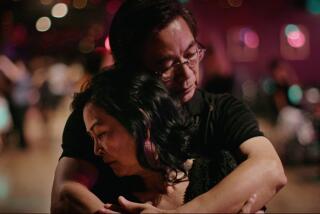DANCE REVIEWS : Beijing’s Take on Tibetan Music, Dance
- Share via
Coming from what a narrator called “the snow-lands of China,” a 13-part folk revue titled “An Evening in Shangri-La” brought Beijing’s view of Tibetan music and dance to Pasadena Civic Auditorium on Thursday.
Against a painting of the Potala Palace in Lhasa (official residence of the currently exiled Dalai Lama), the accomplished members of a 30-year-old company now known as the Tibetan Song and Dance Ensemble of China presented brief samples of everything from ancient masked Buddhist ceremonies to contemporary adaptations of folklore featuring the lush, Westernized orchestrations beloved of Tibet’s Chinese overlords.
With introductions and program notes in English and Chinese, the performance seemed aimed at encouraging the influential ChineseAmerican community to accept the political status quo in Tibet by showing Tibetan traditions being preserved and respected. Moreover, the incorporation of singing styles, sleeve-dancing and gymnastic feats with obvious Chinese equivalents made a statement of comradeship even before the tenor Rinkao’s hearty, clap-along rendition of “Unity” underlined it.
With its gorgeous masks and costumes, along with a beguiling blend of vigorous song and varied character dance, the “Milhareba” (a Tibetan opera) segment not only represented the evening’s highlight, it offered a classic Buddhist reminder that purity of heart can tame both animal blood-lust and human violence.
It may have shocked a few cultural die-hards--including this one--when the dancers impersonated lamas (priests) in condensed, overlapping approximations of sacred rituals.
However, the program as a whole reflected a high level of taste, avoiding the sequined, balletic excesses of dance cavalcades in many major cities of China and, in overall approach, it provided a Chinese/Tibetan alternative to the Russian, Mexican and Filipino popularizations of native traditions so familiar on American stages.
More to Read
The biggest entertainment stories
Get our big stories about Hollywood, film, television, music, arts, culture and more right in your inbox as soon as they publish.
You may occasionally receive promotional content from the Los Angeles Times.










